Kariem Ramee is an ordinary kid. He plays with his brothers and sisters after homework, likes to wear baggy jeans and sometimes gets in trouble for not cleaning his room. When he isn't watching TV or sitting at the computer, he's likely to be sketching in his art pad or writing short stories. He loves science class and Harry Potter books and one day wants to be a teacher, photographer or business owner.
Kariem Ramee also is an extraordinary kid. His favorite music artists aren't 50 Cent, Jay Z or other acts popular with most 8th-graders, but rather those who were making hits long before he was born -- Luther Vandross, Teena Marie, Stevie Wonder. Adults often call him an "old soul" because of his calm demeanor and mature interests, though he blames the distinction on the sprinkling of gray hair he's had since 6th grade.
Mostly, though, Kariem Ramee, 13, is a survivor.
Kariem is one of an estimated 370,000 schoolchildren displaced last year by Hurricane Katrina, the worst natural disaster ever to strike the United States.
On a brisk February afternoon, Kariem sits at a corner table in the library of NOW (New Orleans West) College Preparatory Academy, the charter school he attends in Houston. Tugging at the elastic sleeves on his coat and twirling a pen with his thumb, Kariem describes the day rising floodwaters forced his family to flee their Seventh Ward home.
It was Aug. 30, the day after Katrina slammed into the Gulf Coast. It also was Kariem's 13th birthday. Kariem, his mother, grandmother, aunt, two uncles and five brothers and sisters had escaped a second-story apartment, by boat, with only those possessions they could carry in their arms. The boat quickly capsized, spilling the family and its belongings into the murky depths. Eventually, they made it to a nearby bridge, where they joined dozens of others trapped by the floodwaters.
"We slept on the bridge, and my grandma and my oldest uncle were out there in the heat. My baby brother was out there, and all he got is wet diapers. We were all wet and scared, just waiting on somebody to come get us," Kariem said. "When the buses came, we were on different ones. We couldn't all stay together. That was the worst birthday ever."
Separated for two full days, Kariem and his mother reunited at the Houston Astrodome, where the family remained for more than a month. After losing everything, Kariem longed for only a single item: the three-ring binder that held his drawings and short stories.
His experience would have sounded unimaginable were it not for so many others that played out on the world's TV screens in the days and weeks after Katrina. It is a story he shares with others at NOW, where all 34 teachers and nearly all 350 students in kindergarten through 8th grade are New Orleans evacuees.
NOW is one of 45 charter schools run by KIPP (Knowledge is Power Program), a national network of free, college preparatory schools in economically impoverished communities. Formerly KIPP Phillips Academy, the school was next to the St. Bernard public housing complex in New Orleans, not far from Lake Pontchartrain. It had been open only three weeks when Katrina hit.
A Common Bond
At NOW, which opened in October in an empty elementary school in Houston, principal Gary Robichaux's small office is just across from the library. There, two large posters featuring New Orleans restaurants and the Vieux Carre alphabet remind him of home. On the wall behind him hangs a quote from Eleanor Roosevelt:
You gain strength, courage and confidence by every great experience in which you really stop to look fear in the face. You are able to say to yourself, 'I lived through this horror. I can take the next thing that comes along.' You must do the thing you think you cannot do.
The words are an apt description of the can-do attitude evident to anyone entering NOW's doors. Hallways are papered with photos of students and personal goal statements: "I will do my homework every night." "I will try harder at math." Colorful bulletin boards illustrate New Orleans pride and heritage: "I love my old neighborhood." "I love New Orleans food." A large flag flies above the main hallway, proclaiming: "Recover. Rebuild. Rebirth."
"We wanted as much of the school as possible to feel like home for the students," Robichaux said. "We wanted to make this a place where students feel comfortable talking about what they've been through -- and still remember all the good things about New Orleans."
Even the school colors, Mardi Gras purple, green and gold, and the school symbol, the Louisiana Fleur de Lis inside the Texas Lone Star, were chosen with that goal in mind.
Teachers provide students with home and cell phone numbers and are available after school and on weekends for everything from homework help to pep talks to rides to the mall. Two full-time psychologists help students deal with mental and emotional stress.
"The teachers have done an excellent job building relationships with students," Robichaux said. "Knowing that we've all been through the same experience has made the students feel more at home. Psychologically, I think it has helped all of us deal with the trauma a little better. We've really bonded because of it."
Perhaps nowhere is that bond more evident than in Kyle Shaffer's 6th-grade classroom. Shaffer, a first-year teacher, had been assigned to the New Orleans school through the Teach for America program. When the school reopened in Houston, he jumped at the chance to rejoin the staff.
"I only had a couple of weeks teaching back in New Orleans before the storm, but it was amazing. The kids were great," Shaffer said. "I got to Houston and went to the Reliant Arena to help recruit some of the students here. They've come here and have worked hard."
Students in Shaffer's class are active participants in his high-energy lessons, their eyes following him as he moves about the room, desk to desk, making sure everyone stays on task. A favorite among Shaffer's students is the daily "Sensei Karate Grammar" lesson, where students stand and demonstrate a sentence's punctuation marks with karate-like chops, stomps and the occasional "Hi-ya!"
But not all assignments are as lively. Journaling is a core element in Shaffer's classroom, and sometimes the topics are difficult. Students often write about New Orleans and how Katrina changed their lives. One student writes:
I been feeling homesick since Katrina passed. Every day I say to myself I want to go back home ... I'm not used to living like this. I like coming to school because it is the only place that could feel like home.
The Katrina Krewe: Service Learning and a Sense of Community
It started with a simple e-mail in November 2005. Becky Zaheri, a New Orleans mother of two, decided to send out an all-call to everyone on her e-mail list. She was seeking volunteers to join her in combing the streets of New Orleans, cleaning up bits of trash strewn about the city after Hurricane Katrina.
The response was overwhelming. Young and old, residents from around the city showed up with heavy-duty garbage bags, old gloves and shoes, ready to work.
What started as a small group of acquaintances looking for a way to help their devastated city grew into Katrina Krewe, a massive volunteer effort, including schools, church organizations and businesses. But the group has done more than clean the city's streets; it has restored a sense of community by giving residents the chance to work together for a common goal.
As one observer said in an e-mail to Zaheri: "Katrina Krewe has taken the bull by the horns and is accomplishing what I consider miracles in getting the cleanup job done. A big thank-you to all the volunteers. You are indeed heroes."
It has been perhaps the students who participate in the cleanup effort who have gained the most from the Katrina Krewe experience, learning the power of service during challenging times.
Nearly one-third of about 150 participating groups listed on the Katrina Krewe website are schools or youth groups.
"Being able to have the opportunity to help clean (up) is one I will never forget," wrote one student. "It already has had an impact on my life, and I am ready to encourage everyone to help out in whatever way possible."
Out-of-town and out-of-state school groups have organized cleanup efforts that last a day, a weekend or longer. Local schools have done the same, with many adopting areas around or near their schools for ongoing cleanup efforts.
Online picture galleries show the camaraderie and spirit of these school group cleanup crews, including crews from the Ursuline Academy and the Isidore Newman School.
The Katrina Krewe also plans a campaign for local schools this fall, to raise awareness about the need for ongoing cleanup efforts.
As one 8-year-old participant wrote:
We pick up trash to get a better view
New Orleans can be like new.
You can help, too.
Join the Katrina Krewe!
'They Remember'
Students bound out of the front doors at NOW, wearing bright feathers, glittery masks and beads. Some dance to the beat of Zydeco music streaming from portable boom boxes; others pull elaborate floats atop wagons. One float is a paper-covered tree, with student photos dangling from each branch. Its sign reads, "We're proud of our roots."
Nicole Montgomery, a native of New Orleans, stands in the warm sun outside NOW, along with dozens of other parents and visitors who have come to see the school's Mardi Gras parade. She beams when she spots her niece walking the parade route.
"They remember. You can see it: These kids remember," says Montgomery, who also has three children at NOW. "Throwing the beads, putting the party floats together, they are never going to lose the New Orleans spirit."
Though Montgomery says she and her children miss the food and festive culture of home, she doesn't plan to go back. There are too many things she doesn't miss about New Orleans: high unemployment, heavy crime, extreme poverty, inadequate schools -- all the dire social inequalities Hurricane Katrina so vividly exposed.
"I have a better chance of giving my kids a better life here. It's a much better environment," Montgomery said. "The kids like their home here; they like their school."
Robichaux has heard such comments from many parents at NOW. Other parents do plan to return to New Orleans, he said. Ultimately, Robichaux would like to see NOW return, too.
Britta Ostermeyer, assistant professor of Psychiatry and Family and Community Medicine at Houston's Baylor College of Medicine, believes schools like NOW have many benefits for displaced students.
"They have the advantage of a support system in being with students and teachers who have similar backgrounds, similar stories," Ostermeyer said. "The kind of school where students' home traditions and cultures are honored helps foster a sense of belonging, especially for families who plan to go back to New Orleans."
Ostermeyer cautions against seeing schools such as NOW as a long-term solution for families planning to remain in Houston or other new communities.
"At some point, the families will need to find ways to integrate themselves into their new communities and learn more about the culture and traditions of those places," she said.
'With Open Arms'
With some 20,000 displaced students in the Houston area, not every school has been able to provide evacuees with the sense of home found at NOW. Displaced students attending existing Houston schools face a new set of challenges, balancing worries about fitting in with the need to retain their own senses of identity. That challenge has been difficult in some schools, where reports of tension and even physical violence between Houston and New Orleans students have captured headlines.
Still, there are success stories. At Jack Yates High School in Houston, educators and students placed strong emphasis on creating a welcoming atmosphere for the nearly 200 displaced students enrolled there.
"Initially, I was concerned about some things I saw," said George August, Yates' principal. "Understandably, the students from New Orleans seemed to want to group together. There was a sense of safety in numbers."
Ciera Singleton, an 18-year-old senior from New Orleans, arrived at Yates in mid-September and found it difficult to fit in. "We had to come here and adapt to change, adapt to new people, learn Houston," she said. "We did feel like we needed to stick together at first. People looked at us like we were different because of the way we talk and the way we dress and look."
Soon after New Orleans students started arriving at Yates, August made several schoolwide intercom announcements to emphasize the importance of pulling together, helping others and easing the transition for student evacuees.
"It matters for the principal to say it; it does set the tone," August said. "The message I wanted to get across was that when you become a student of the school, you are the school. Yates belongs to every student who is here."
Students played a role in setting the tone, too. Many had visited the Astrodome, spending time with children there and donating supplies and money they had collected at school.
Student council president Cloydia Garrette, 17, said most classmates welcomed the New Orleans students to Yates "with open arms."
The school held a special breakfast welcoming the new students. A buddy-system paired Houston and New Orleans classmates together, sparking new friendships and helping those from New Orleans learn more about their new school and community. Houston students also realized there were things they could learn from their new classmates.
"We've picked up some of their vocabulary and learned a lot about some of the dance styles and types of music they listen to," Cloydia said. "I think we all have to know that, hey, you can't be closed-minded. They are missing a lot, but they are adding some new things here from their experiences."
Principal August said many of the students from New Orleans are "exceptionally talented" and have become active members of the school, signing up for extracurricular activities, clubs and sports teams.
Terrance Johnson, a 17-year-old senior from New Orleans, is one student who has added a great deal to Yates. Terrance, who arrived in Houston on a church van two weeks after Katrina hit, is a gifted trombone player and now a member of the Yates band. When he isn't playing trombone, Terrance stays busy working as a janitor for the local church that provided him shelter when he first arrived.
Terrance wishes the media would tell more positive stories about how displaced students are faring in Houston schools. "It's like that's what people want to see, the negative stuff, the fighting and people not getting along," he said. "They need to show how we are coming together, because that is the New Orleans tradition — that's what we do."
'Houston City Limits: Welcome'
With help from art majors at nearby Texas Southern University, several Yates students — from Houston and New Orleans — spent more than 160 hours working together to create a mural depicting various scenes of loss, hope and healing. The mural is a permanent monument to both the tragedy wrought by Katrina and the bridges that have been built at Yates.
Large purple and white letters spell out the phrase, "Strength Thru Unity," the mural's theme. The letters fade into a winding road that ends at a highway sign announcing, "Houston City Limits: Welcome."
"It was a way for us to show we have unity, spirit and pride," said Lauren Jackson, a 17-year-old junior from Houston. She teamed up with 18-year-old senior August Fleming, from New Orleans, to paint a section of the mural. They created two colorful heart lockets, one representing Texas and the other representing Louisiana, linked by a golden chain.
"I got to express myself and let go of some anger I was feeling about having to leave home," August said, standing beside her section of the mural. "I pass it every day, and it's nice knowing I helped work on it."
While the mural project has been cathartic for many students, it also has proved to be a learning experience, with some difficult moments along the way. One mural scene -- hands rising from water, reaching out for help -- was intended to illustrate charity and compassion. For many New Orleans students, however, it was too painful a reminder of lives changed and lost.
"It's understandable when people have suffered trauma, seeing images that remind them of that experience can be very stressful," said Ostermeyer, the Baylor psychiatry professor. "Art is an excellent way to help students express feelings about what has happened to them, but sometimes it's helpful for schools to try and come up with projects or elements not directly related to the tragedy."
When mural artists learned of the emotional responses the scene evoked, they discussed many solutions, ultimately choosing to paint over the hands with the word "together." Principal August said the experience was a good lesson for the school, and illustrated the importance of maintaining open channels of communication.
Lost and Found
One year after Hurricane Katrina, it is clear that, much like the rebuilding of New Orleans, the healing process for the hundreds of thousands of students affected by the tragedy will be a long-term effort.
"There are many things that will need to be looked at down the road," Ostermeyer said. "For many of the students this is a process of bereavement, which typically takes about a year to process and deal with the loss."
Students like Kariem at NOW have learned that, some days, the healing process is easier than others. There are the difficult days, when memories of home feel like too much to bear.
"I get sad sometimes because I just miss it," he said. "It's all I knew."
And there are the days when home feels a little closer -- like the day Kariem's uncle returned from a trip to New Orleans with the three-ring binder Kariem thought was lost forever.
"That was a good day," Kariem said. "My uncle went back to New Orleans to find his graduation pictures because he had just graduated before the storm came. I was happy he got his pictures, and it felt real good to see my binder and have something that was mine from home."
The first thing Kariem removed from the notebook was a short story he'd been working on before the hurricane. He said he was eager to finish the story -- about a boy who made friends with the school bully in detention -- and submit it to a publisher of youth writings.
"I got a lot of other stuff I can write about if they don't like it," he said. "Maybe I can write about my story."
He added: "I'd give it a very good ending."
After Katrina: A Teacher's Year
Mr. Shaffer?"
Ceion motioned me over to his desk. I knelt down so we could talk at eye level. We were in the middle of a poetry activity during the second day of school in very early October 2005, little more than a month after Hurricane Katrina had hit.
"My cousin?"
Ceion said everything like a quiet question even though it was fact -- partly because that's how 6th-graders talk, partly because of what he was about to say.
"We was on the bridge? And this little boy? He was in the water?"
"During the hurricane?" I asked just to let him know I was there.
"Yeah. And my cousin? He had saved the little boy. But my cousin? He had drowned."
I froze for a second, uncertain of what to say next. I had just hit the surface of what -- as I would come to find out -- my students had gone through in Katrina's aftermath: swimming through the dirty, mucky, infested water for safety, watching people drown, sleeping on bridges, waiting without food, separated from family members, spending days and weeks on cots in the different arena-turned-disaster-relief-shelters wondering what had happened to home.
"He' s a hero, Ceion." I said. "I know it's so hard to think about that, but he is. I'm so proud of you for telling me that, and I'm so glad that you're here at this school."
"Yeah," he whispered.
"Make sure you tell me whenever you want to talk about anything. OK?"
He nodded. I patted him on the back and gave him a smile.
From Home to Houston
Less than 24 hours before Katrina hit, I awoke in my bed in New Orleans to newscasters looking me dead in the eye through the TV, "If you're still in New Orleans, you shouldn't be. You need to get out," they demanded -- I got out. I ended up in Atlanta, but I wanted to be back in New Orleans. I wanted to help, but I had no clue what to do.
As thousands of New Orleans evacuees were bused and flown all over the country, the opportunity arose for me to teach in Houston, where there had been a large influx of Katrina evacuees. I flew there thinking I would be placed at a regular Houston public school with a lot of New Orleans students. But I arrived to find generalized chaos. There were overflowing classrooms and schools in Houston, and all we wanted to do was teach and help the schools, but red tape and logistics kept that from happening right away.
The uncertainty settled when KIPP, a respected and successful national charter school based in Houston, decided to start a school from scratch. That's how I found myself walking up and down the rows of cots in the Reliant Arena, one of the largest relief shelters for Katrina evacuees in Houston. Working with other teachers, I held a posterboard sign written in colorful Crayola markers:
"New Orleans Students. New Orleans Teachers. New Orleans School in Houston."
The school we were promoting -- made up of New Orleans students and teachers starting fresh in Houston -- did not yet exist, but we were confident it soon would.
"Praise the Lord!" one of the first women in Reliant Arena cried when we described the school. "That's what these children need...a New Orleans school. God bless you!"
It was depressing at times, but motivating too to talk to hundreds of children and parents about rebuilding their lives in Houston. People who had lost virtually everything were in vital need of a sense of home.
So when 400 students, grades K-8, walked into New Orleans West College Prep (NOW) in Houston on the first day of school, no one felt like an outsider.
You could see their comfort levels rise further when we tossed a ball around as an introductory game on the first day of school, and each student announced to the class the name of the school they attended in New Orleans.
Writing and Healing
As a writing teacher, I was able to get to know the students, their imaginations, and their stories better than anyone.
"Everyone was asleep until -- Boosh! -- a tree branch hit my grandmother's window," one student wrote. "My sister and I went downstairs then we peeked outside the window. Cars were upside-down on the streets. Trees were moving really fast. Then we went back upstairs and told everyone. We laid down for three minutes. I saw water coming from the door. I told my grandmother, 'Water downstairs.' She said turn it off and close the door. I said, 'NO! Not that! From outside!!' Then soon I looked and the water was over the third step. All of us kept looking out the window. We heard a car alarm went off. The water was really high. I was lucky I was with my family...."
I used topics of New Orleans and Katrina all the time -- ranging from serious opportunities for them to journal about Katrina and their transition to Houston to relaxed discussions about what makes New Orleans a great place.
Even students who did not like sharing their experiences in front of the class trusted that in their journals they could write to me honestly about Katrina and life in Houston.
"I can't have any fun because half my family is on the other side of Houston, some went back to New Orleans, some are in Colorado," one student wrote in early October. "I don't know where all my cousins are. Some of my friends I know from New Orleans I miss very much."
As the year went by, students wrote about Katrina less and less. Of course discussions would often come up about Katrina -- what could be done to fix New Orleans, life in Houston, or other topics.
I don't remember even talking about Katrina during the last month or so of school. It probably happened, but we were so focused on our academics that it kind of fell to the side. At that point, our students had gained multiple grade levels in reading and math, and we were in full stride as a focused team.
'You're Like Family'
In the end, I knew in my mind that we had achieved our goal. Our kids had found that sense of home. They would cheer each other on in class, proudly chant New Orleans rhymes together, work well together, and were open and trusting with their teachers and classmates.
One moment confirmed it for me for good.
A short, sometimes shy student had come to NOW with a huge attitude problem, lagging behind academically. By year's end, he had passed both state tests and become a positive influence among his classmates. At lunch one day, he came up to me, smiling and even blushing a bit. He looked me in the eye and said, "You know what Mr. Shaffer?" (He had that same tone as Ceion had on the second day of school, saying his sentences like questions.) "You and Mr. Lamb and Ms. Mann? You're like family."
The truth is, they became my family, too. My students taught me. I learned about what can happen when people come together, how people can persevere through amazing things and come out on top. I am back in New Orleans now, teaching a few of the same students from last year. Other students are elsewhere — maybe in Houston, maybe in Austin, maybe in Dallas. Who knows? Wherever they go, I know the past year helped, that after the chaos and devastation caused by Katrina, we all benefited from our own little bit of New Orleans in downtown Houston.
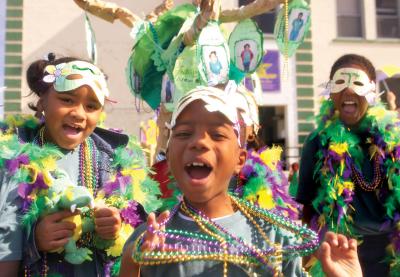
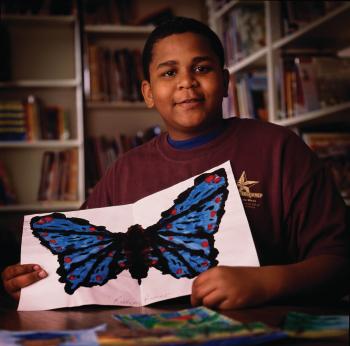
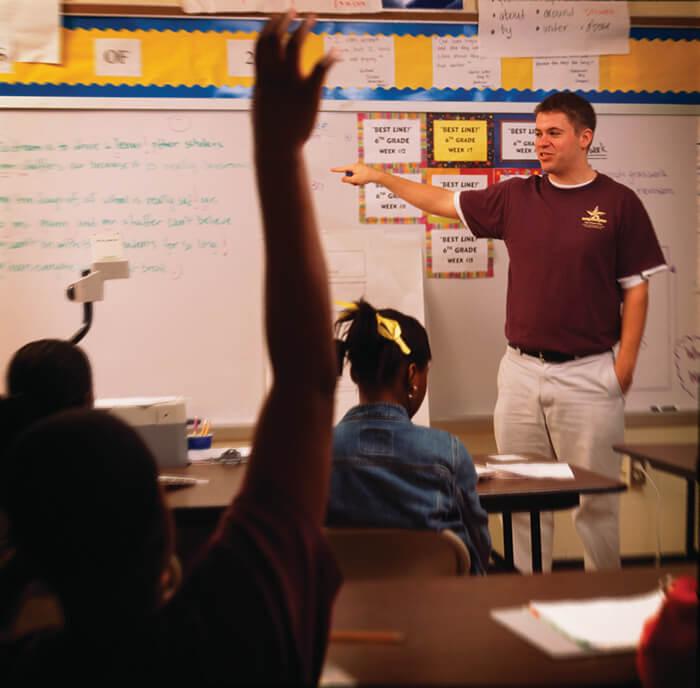

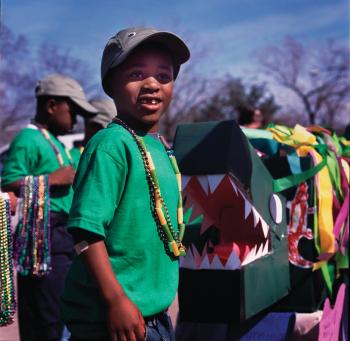
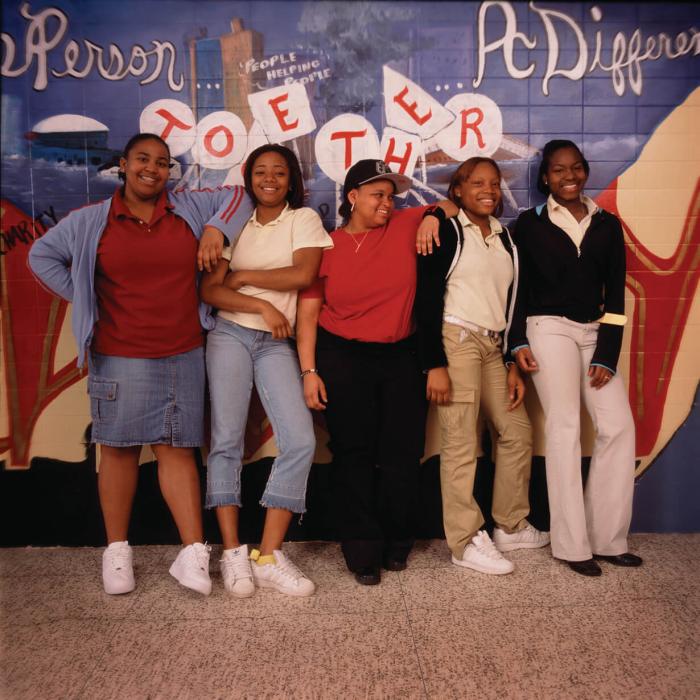
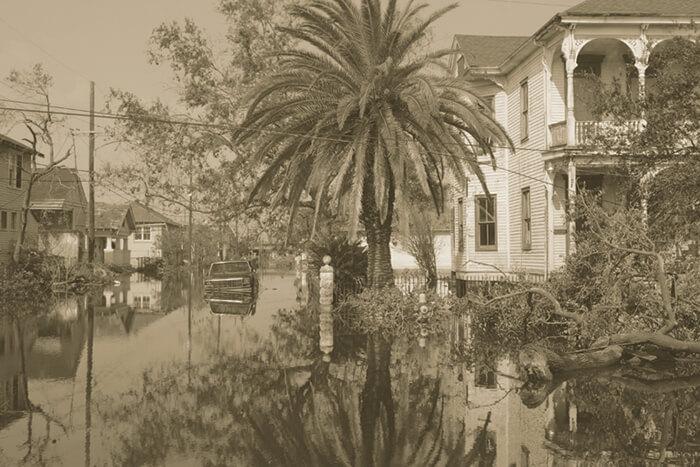

0 COMMENTS